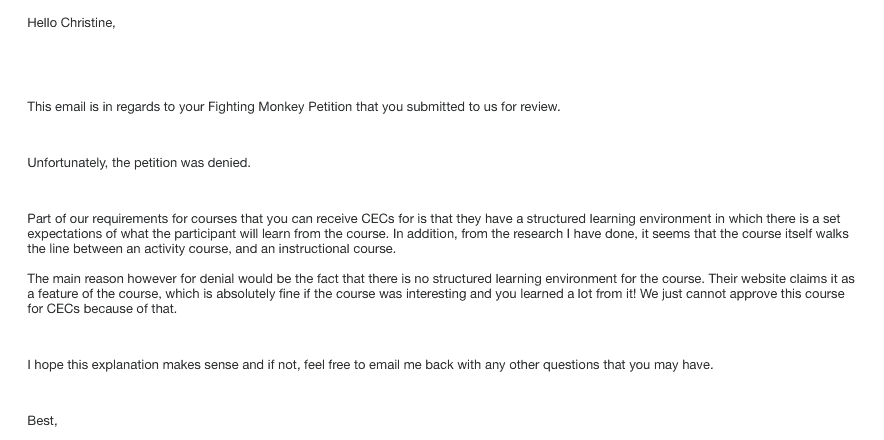
Certs, Workshops, and Continuing Ed
Information is a tease that lures you to attach yourself with a particular paradigm. The consequence of consuming the free tastes is that you are left deficient. Once sampled, you’re not entirely sure what you just had, but you do want to know when and where you can get more. How much it costs is always the second question you ask.
We invest in workshops or seminars because we want to learn and do, under an assumed application. We want a fresh lens in which to observe, analyze, and adjust our world. The investments we make (time, money, focus) into this new framework make us want to utilize it in every possible way. We become skewed, intentionally, because we’re looking for some kind of distortion.
Workshops offer an experience. You are guided in a way. Throughout, you establish your own meanings and connections and are most often tasked with the responsibility of how. Seminars or certifications purposefully deconstruct their how. You are given systematic insight into a particular approach. While both are beneficial, seminars tend to cost a lot more because they are tied to a certificate which qualifies as accreditation.
We continue our education every day, watching and following, reading and analyzing. We curate and like what we find interesting. The tenacity in which some pursue theories and carry out experiments epitomizes the learning demonstrated in diplomas of higher ed. They will never be included in such company, however, because research outside the system legitimized by the system is a threat to the sustainability of the system.
The impulse to Fight Club it all is calmed by the smallness of the hoops we are asked to jump through. It’s much easier to tread lightly and do just a little more than to dynamite the whole thing to the ground.
The following is a true story.
On October 19, 2017, Erwan Le Corre tweeted that he would certify any practicing Physical Education in MovNat for free. (The random way I spotted the tweet when I’m rarely on twitter felt doubly fortuitous). MovNat was pretty much off my radar, but after looking up how much the Level 1 cert cost I immediately acted to seize this opportunity. The funny thing is, if it had been a couple hundred bucks I probably would have passed on it. There is such perceived value tied to cost. We have been programmed to believe that what is given away as partial or less than.
A two-day MovNat workshop costs $420. A certification costs $1350. The price would lead one to believe that the certification is worth three times as much as the workshop. But the difference was only a few frustrating hours. Workshops and certifications are combined into the same events. Those seeking certs came early and stayed late each day so we could be individually assessed on our competence with selected movement skills. There was also some observation of us coaching, but though several missed their correctives, no one was failed in this category like they were on the physical proficiencies. Greater emphasis was placed on being able to perform than to utilize or instruct.
To be fair, I was very impressed with the handbooks MovNat provided the cert level participants. They were well thought out, gave an excellent overview of their system and philosophy, and carefully broke down their movements into functional purpose and parts. Perhaps this is what all the extra cost came down to. It would certainly be more justified. Still, I don’t attend seminars to come away with a book to read.
I want to learn, first-hand, the intended, systemic process of a methodology, and, more importantly, how it is presented.
The workshop people had a ball. They jumped and threw and balanced, playing and moving for a reasonable amount of time. When they left, the energy in the room tanked. The cert folk still had tests and scenarios to participate in. At our most tired and hungry we were getting graded.
In the month between learning of the MovNat seminar and the actual taking and completing, I got audited to submit my CEU’s for my Chiropractic Assistant’s license, and my American Council on Exercise personal training license was soon to expire. Since I knew MovNat was still a ways off, I petitioned (filled out a form along with $25 dollars) to use my Fighting Monkey workshop from May.
I got denied by both, but at least ACE gave me a formal reply. Luckily, my upcoming MovNat Level 1 Cert did check all of the standardized boxes. It only cost me another $25 to petition, as it was mysteriously removed from the pre-approved list this year.
It did not matter how much evidence I provided showing a lack of structure makes learning more effective, or that training for a job that entails prescribing movement should absolutely be active in nature, their answers were final.
The Oregon Board of Chiropractic denial was especially irritating because a 2-hour video about how great chiropractic was did count. It was a taping of the keynote speaker from their yearly conference. (I was not surprised that 90% of the chairs in the lecture room were empty.) They took my $40, sent me a link, and I played it while I cleaned my house.
Business so often gets in the way of personal improvement.
The way certifications are marketed also seems to be evolving. Instead of making better teachers with better tools, they are appealing to the conquering warrior. If you can show you can do tough stuff the folks will flock to you. Note the difference between these two MovNat promotional videos. The first currently resides on their ‘Get Certified’ page, and the second is one from 2012 (possibly the original) that popped up via YouTube:
The growth of beings over systems is clear here. The last gentleman featured and narrating this original video is a senior student/teacher of Fighting Monkey.
This newest level three edit was particularly convincing of the new direction of things:
Though MovNat is the circular example used, they are not intended to be the villains, nor are they alone in limiting access to create an aura of elitism. My beloved Fighting Monkey, for example, is having a five day intensive two hours from my home, but the cost $2500 to attend. FRC requires those who become Kinstretch certified pay $100 a month in franchising fees on top of the $900 it costs to attend the seminar. If the goal of these organizations is to truly help people, why price so many out of participation?
The implosion, though, may be coming. As more and more people realize they do not need a certification to work with clients (only competing coaches/ trainers seem to care about this), the writing is on the wall to bypass the costlier paper chase and opt for the more affordable workshop experience. There, interpretations are shared and tried, and one is able to immerse themselves in actual practice. Interacting with others of various backgrounds, we can form our own relevance and tangents of the information being presented.
Coming together in a communal space is an attempt to evolve. For a moment in time, we are part of a club. The privileges of membership, though, minimize dramatically once you’re out the door. Unless the cultivator and creator in us kicks in, we’re left with yet another binder for the shelf. Struggling to make space and organize a hierarchy, we are reminded that all dusty notebooks were once a good idea.





